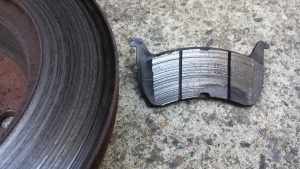A car came into the workshop last week with some brake shudder. The owner was quite irate and informed me that he had recently had the brakes repaired at another local shop and now there was something else wrong. Later that day, I pulled the wheels off for my first inspection. I could hardly believe it, there was a shiny new set of front pads, but also old rotors that clearly had been damaged previously by old pads that were down to the metal.
I rang the owner to ask him to come down to view the issue and ask what was going on. He came over and looked at the brakes. It was at this point he had admitted that he had told the mechanic to do it as cheaply as possible. He thought the mechanic must have done some damage to the rotors because they weren’t shuddering when it was given to him in the first place. Of course, the most likely explanation was that he didn’t notice the shudder because the brakes were hardly working in the first place and now the old and new surfaces were trying to work together. Surprisingly, the owner also asked me to fix it as cheaply as possible. I could hardly believe what he was saying. I said I would have a look and give him a quote.
Once I pulled it apart, one of the front bearings had run virtually dry and the other had some wear, possibly caused by the overheating of the metal on metal contact. So the owner is now looking at new rotors, new bearings, new pads, prevailing torque nuts, sundries, and labor.
I called him to explain the cost for repair and he told me that the pads were nearly new so I should “reuse them”. Reuse the old nuts and only to replace one bearing? I gave him a choice: repair and replace all parts, including new pads, as suggested or I won’t be doing anything at all. I also discussed how he drove the car, as the driving style would indicate which type of pad and rotor should be fitted. This was a bit of a challenge, as he felt that pads were pretty much all the same (see Michael Rivera's article on brake compositions) and that different rotors wouldn’t make any difference at all. A lengthy discussion ensued in which a number of options were provided. He of course went with the cheaper pads and rotors, but I felt comfortable because I knew he didn’t drive the car aggressively anyway.
He picked up the car the next day and I felt relieved to know that he had good, reliable brakes, and that I won’t be the cause of any accident because of my workmanship.
Let's hear some of your stories about problematic brake jobs you've seen. Share them with me in the comments below.











